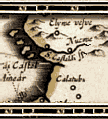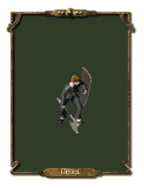







|
|
|
|
Unlike dwarves, gnomes are not possessed of an especially powerful physique, and they do not display exceptional strength; their physical powers are more in keeping with their stature, which is quite small. Gnomes average less than 40 inches or 100 centimeters in height, and usually weigh some four or five hundred stone at most. However, they do possess uncommon endurance and longevity! The natural life span of a gnomish male is some 500 years, barring accidents and illness.
Aside from these superficial differences, which can be subtle to the untrained observer, the main difference between gnomes and other Minutes is in character. Here the contrasts are sharp and defining! For example: whereas dwarves make their homes almost exclusively in mountainous regions, gnomes are not confined to any particular locale; they are found everywhere that there is commerce and trade. And, while dwarves live in a closed and insular society, preferring to avoid contact with other races as much as possible, gnomes are free-ranging and cosmopolitan. Halflings are a shy, retiring, and largely sedentary folk; gnomes are fiercely energetic and driven. Of all Minute peoples, gnomes are the most likely to travel, learn new languages, and appreciate all that is novel and foreign to their experience. At the heart of the world-famous gnomish ambition, which has inspired so many gnomes to become bankers, politicians, and captains of industry, one always finds a strong desire for security. Outside observers, who tend to pass judgement based on surface appearances, have often condemned the gnomish people for their love of gold and power; but in doing so, they ignore the motivation behind any gnome's quest for wealth. Gnomes do not love money or influence for their own sake! It is the desire to provide assurances for himself and his Family that motivates the average gnome. It must be noted that the ordinary gnome, once stripped of his fortune and title, is a highly vulnerable person. Gnomes are not so well able to defend themselves as dwarves are, in a physical sense; they also do not have impassible mountain ranges to hide behind. If a gnome is to enjoy any peace of mind, then, he must have some means of providing for himself and his loved ones. Some barrier must be erected between himself and the world, which is full of dangers. Before being quick to pass judgement, it may be wise for us to remember that a gnome may spend up to 100 years as a pensioner! Also, the devotion and duty which a dwarf gives to his Clan is mirrored, in gnomes, by their allegiance to the extended Family, to which any gnome's loyalties are final and absolute. Siblings, parents, grand-parents and other living ancestors, cousins and cousins-by-marriage…as a member of the Family, any given gnome is expected to assume responsibility for the health and welfare of up to one hundred people, once all his relations are counted. This burdensome thought is bearable to him, of course, because every other member of his Family is also working just as hard as he is, devoting untold energy to the Family's support. All of these efforts are directed by the head of the Family, who coordinates the efforts of every gnome bearing the Family name, giving each a set of responsibilities and duties to perform. The gnomish love of Family gives their lives purpose and direction, as well as a personal security which other races, for the most part, can only envy. Great are the benefits enjoyed by the rare outsider who impresses a gnomish Patriarch enough to be adopted as a "godson" to the Family! There is a dark side to all this, however; not only can power struggles within the Family turn ugly, but gnomes are known to exact terrible and bloody revenge on anyone who harms or threatens a Family member. No one can hold a grudge like a gnome! They live long, remember every offense against them with perfect detail, and they do not make nice distinctions between the person who once did them wrong and his descendents, 100 or 200 years later. Women and children are particularly cherished by the gnomish Families, and gnomish ladies, although not as cloistered as their dwarven counterparts, are still rarely seen traveling abroad or even walking the streets unless they are accompanied by a formidable entourage of escorts and bodyguards. Trained half-ogre protectors are a common sight on the streets of any large city; they accompany all gnomish people of substance.
|

 nomes, like dwarves and halflings, are a Minute Race. They are descended from Dwarven stock; according
to our limited fossil finds, the first true gnomes appeared over seven hundred thousand years ago, in
what is now Cumbria. It would seem that the divergence of gnomish and dwarven races occurred by the
ordinary process of Natural Selection, rather than by magickal intervention. This theory is supported
by alchemickal testing of gnomish tissue, which yields no distinctive mystic vibration for their species.
Accordingly, like all products of pure natural selection, gnomes have no special advantage in the practice
of Magick. They are not particularly known for its use.
nomes, like dwarves and halflings, are a Minute Race. They are descended from Dwarven stock; according
to our limited fossil finds, the first true gnomes appeared over seven hundred thousand years ago, in
what is now Cumbria. It would seem that the divergence of gnomish and dwarven races occurred by the
ordinary process of Natural Selection, rather than by magickal intervention. This theory is supported
by alchemickal testing of gnomish tissue, which yields no distinctive mystic vibration for their species.
Accordingly, like all products of pure natural selection, gnomes have no special advantage in the practice
of Magick. They are not particularly known for its use.
 Superficially, gnomes can also be distinguished from other Minute peoples by their facial features and
feet. Unlike their dwarven cousins, a beard is not standard fare for a gnomish male. They also do not
possess oversized and hairy feet, as halflings do. The only remarkable physical feature of the common
gnome is his or her nose, which is usually large and fleshy. Like all Minute races, gnomes are possessed
of exceptionally keen senses in general, but the size of the gnomish nose may account somewhat for a
gnome's sense of smell, which is extremely precise and exacting. In this particular faculty, in fact,
they are second to none! The gnomish sense of smell may go far to explain the great success they have
enjoyed as chemists and perfume-makers.
Superficially, gnomes can also be distinguished from other Minute peoples by their facial features and
feet. Unlike their dwarven cousins, a beard is not standard fare for a gnomish male. They also do not
possess oversized and hairy feet, as halflings do. The only remarkable physical feature of the common
gnome is his or her nose, which is usually large and fleshy. Like all Minute races, gnomes are possessed
of exceptionally keen senses in general, but the size of the gnomish nose may account somewhat for a
gnome's sense of smell, which is extremely precise and exacting. In this particular faculty, in fact,
they are second to none! The gnomish sense of smell may go far to explain the great success they have
enjoyed as chemists and perfume-makers.